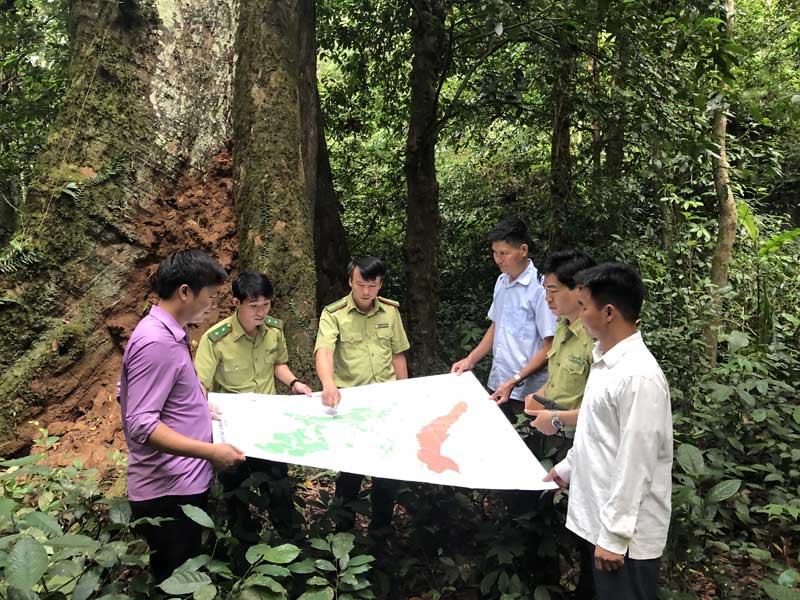
(HBO) - Setting foot in the primary forest in Nhuoi village, Da Phuc commune of Yen Thuy district, our tiredness seemed to fade away. Under the shadow of old-growth trees, the air was fresh and cool. It was just 2 o’clock in the afternoon, but Truong Duc Hoa, a forest ranger of Da Phuc reminded us to quickly do our reporting as dawn would fall quickly in the forest.
 Forest management
force in Yen Thuy district has kept a close watch on local forests, while
coordinating with the local Party Committee and government to manage, protect
and develop the forests.
Forest management
force in Yen Thuy district has kept a close watch on local forests, while
coordinating with the local Party Committee and government to manage, protect
and develop the forests.
Entering the centre of the forest, we were overwhelmed by the
towering Cho Chi (Parashorea chinensis) trees which are hundreds of years old.
The diameter of the trees’ trunks was nearly 2m, while their foots were so big
that 7 - 8 people extending their arms could not circle around them. Indeed, 13
Parashorea chinensis trees in Da Phuc forest deserved the title of national
heritage trees. The primary forest in Nhuoi village covers more than 30
hectares, with its core area spanning nearly 10 hectares.
In order to protect and develop the forest in Nhuoi village
and the whole commune in general, over the year, the Party Committee and
government of the commune have joined hands with all sectors, mass organisations
and forest management force to promote communication work to enhance public
awareness about and sense of responsibility towards forest management and
protection.
Meanwhile, regulations and rules on coordination in forest
protection have been built, together with the signing of commitments with local
households. At the same time, forest protection teams have been set up
to perform regular patrol and inspect the forest, thus quickly detecting
violations to forest resources.
Irrigation works in the locality have been exploited
efficiently thanks to the strict protection of watershed forests and the
reduction of barren land due to forestry economic development movements.
The resources from the forest have helped Da Phuc form a
commercial goods production region. Currently, the commune has over 650
hectares of material sugar canes and nearly 200 hectares of solanum trilobatum.
Particularly, with the untouched and attractive natural
landscapes that are protected by locals, the primary forest is expected to help
Da Phuc develop ecotourism to attract domestic and foreign visitors, creating a
breakthrough in the economic structure transformation in the locality./.
Hoa Binh province is undergoing a dynamic transformation amid Vietnam’s national digital transition. Building on Poliburo’s Resolution No. 57-NQ/TW on breakthroughs in science, technology, innovation, and national digital transformation, the province has rolled out a wide range of practical action plans. A standout initiative is the "Digital Literacy for All” movement, an effort to ensure that no one is left behind in the digital era.
Hoa Binh province is undergoing a dynamic transformation in the wake of the national digital transformation movement. Building on Resolution No. 57-NQ/TW of the Politburo on breakthroughs in science, technology, innovation, and national digital transformation, the province has implemented a wide range of practical action plans. A standout initiative is the "Digital Literacy for All” movement ambitious effort to ensure that no one is left behind in the digital age.
With a spirit of unity and proactive problem-solving, the Party Committee, the government and the people of Dong Lai Commune (Tan Lac District) have made great strides in implementing the resolutions of the 24th Party Congress of the commune for the 2020 - 2025 term. Focusing on leadership and practical actions, the commune has brought the Party’s resolutions into daily life, creating strong impacts and pushing the local development forward.
Amid the nationwide push for digital transformation, young people in Hoa Binh Province are stepping up as dynamic pioneers, applying technology to enhance Youth Union operations and expand the reach of youth-led initiatives. Through creativity and adaptability, Youth Union organizations at all levels have introduced a series of practical solutions, contributing to modern governance and community development.
In recent years, An Nghia commune, located in Lac Son district, has stepped up administrative reform, focusing on improving the quality and efficiency of its single-window service unit for receiving and processing administrative procedures. These improvements have helped create favourable conditions for local residents and organisations to handle administrative procedures, contributing to the commune’s broader socio-economic development.
The Prime Minister-approved master plan to develop the multi-use value of forests ecosystems through 2030, with a vision to 2050, aims to improve the management and sustainable use of forest resources, create jobs, increase incomes, and improve the living standards of ethnic minorities, people in mountainous and remote areas, forest workers and those living near forests.



 Forest management
force in Yen Thuy district has kept a close watch on local forests, while
coordinating with the local Party Committee and government to manage, protect
and develop the forests.
Forest management
force in Yen Thuy district has kept a close watch on local forests, while
coordinating with the local Party Committee and government to manage, protect
and develop the forests.